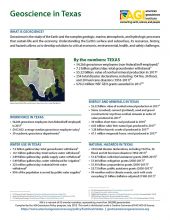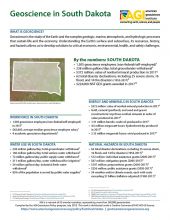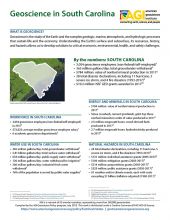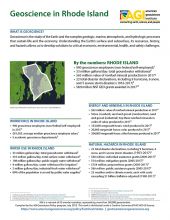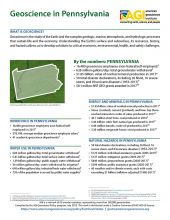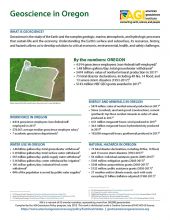By the numbers: Tennessee
- 5,302 geoscience employees (excludes self-employed)1
- 430 million gallons/day: total groundwater withdrawal3
- $1.14 billion: value of nonfuel mineral production in 20174
- 68 total disaster declarations, including 31 severe storm, 17 flood, and 11 fire disasters (1953-2017)⁶
- $2.22 million: NSF GEO grants awarded in 201714
What is Geoscience?
Geoscience is the study of the Earth and the complex geologic, marine, atmospheric, and hydrologic processes that sustain life and the economy. Understanding the Earth’s surface and subsurface, its resources, history, and hazards allows us to develop solutions to critical economic, environmental, health, and safety challenges.
Your State Source for Geoscience Information
Workforce in Tennessee
- 5,302 geoscience employees (excludes self-employed) in 20171
- $73,201: average median geoscience employee salary1
- 9 academic geoscience departments2
Water Use in Tennessee
- 430 million gallons/day: total groundwater withdrawal3
- 5.99 billion gallons/day: total surface water withdrawal3
- 850 million gallons/day: public supply water withdrawal3
- 64 million gallons/day: water withdrawal for irrigation3
- 734 million gallons/day: industrial fresh water withdrawal3
- 91% of the population is served by public water supplies3
Energy and Minerals in Tennessee
-
$1.14 billion: value of nonfuel mineral production in 20174
-
Stone (crushed), zinc, cement (portland): top three nonfuel minerals in order of value produced in 20174
-
640,000 short tons: coal produced in 20165
-
270,000 barrels: crude oil produced in 20175
-
150,000 megawatt hours: solar produced in 20175
-
7.61 million megawatt hours: hydroelectricity produced in 20175
Natural Hazards in Tennessee
- 68 total disaster declarations, including 31 severe storm, 17 flood, and 11 fire disasters (1953-2017)6
- $196 million: individual assistance grants (2005-2017)6
- $149 million: mitigation grants (2005-2017)6
- $260 million: preparedness grants (2005-2017)6
- $44 million: public assistance grants (2005-2017)⁶
- 69 weather and/or climate events, each with costs exceeding $1 billion (inflation adjusted) (1980-2017)7
U.S. Geological Survey (USGS)
- $1.15 billion: total USGS budget in FY 2018 (5.8% increase from FY 2017)8
- The National Cooperative Geologic Mapping Program funds geologic mapping projects with federal (FEDMAP), state (STATEMAP), and university (EDMAP) partners
- $1.06 million: Tennessee STATEMAP funding (1993-2016)9
- Tennessee Technological University, Vanderbilt University, and University of Tennessee have participated in EDMAP9
- USGS streamgages collect real-time or recent streamflow, groundwater, and water-quality data in Tennessee
National Aeronautics and Space Administration (NASA)
- $20.7 billion: total NASA budget in FY 2018 (5.5% increase from FY 2017)10
- 1.9 billion: total FY 2018 NASA Earth Science budget (0% change from FY 2017)10
- Gravity Recovery and Climate Experiment (GRACE) satellites measure groundwater changes in Tennessee
- Soil Moisture Active Passive (SMAP) satellite measures soil moisture in Tennessee
National Oceanic and Atmospheric Administration (NOAA)
- $5.9 billion: total NOAA budget in FY 2018 (4.1% increase from FY 2017)11
- Next-generation geostationary (GOES) and polar orbiting (JPSS) satellites provide weather forecasting for Tennessee
- Deep Space Climate Observatory (DISCOVR) satellite monitors radiation and air quality over Tennessee
- 9 National Weather Service Automated Surface Observing Systems (ASOS) stations in Tennessee12
- 169 National Weather Service Cooperative Observer Program (COOP) sites in Tennessee12
National Science Foundation (NSF)
- $7.8 billion: total NSF budget in FY 2018 (4% increase from FY 2017)13
- $1.4 billion: total NSF Geosciences Directorate (GEO) awards in FY 2017 (7.2% increase from FY 2016)14
- 13 NSF GEO awards in Tennessee totaling $2.22 million in 201714
- $849,000: NSF GEO grants awarded to University of Tennessee Knoxville in 201714
U.S. Environmental Protection Agency (EPA)
- $8.1 billion: total EPA budget in FY 2018 (0% change from FY 2017)15
- 18 active Superfund sites in Tennessee in 201816
- $8.24 million: Drinking Water State Revolving Fund (DWSRF) grants in Tennessee in 201717
Federal Facilities in Tennessee
-
USGS NOROCK Southern Appalachian Duty Station, Knoxville
-
DOE Oak Ridge National Lab, Oak Ridge
-
NOAA Air Resources Laboratory, Oak Ridge
-
USGS Patuxent Wildlife Research Center, Memphis
References
1. U.S. Bureau of Labor Statistics, Occupational Employment Statistics, May 2017
2. American Geosciences Institute, Directory of Geoscience Departments, 53rd Edition (2018)
3. U.S. Geological Survey, Estimated Use of Water in the United States in 2015
4. U.S. Geological Survey, Mineral Commodity Summaries 2018
5. U.S. Energy Information Administration
6. FEMA Data Visualization: Summary of Disaster Declarations and Grants (accessed May 2, 2018)
7. NOAA National Centers for Environmental Information, U.S. Billion-Dollar Weather and Climate Disasters from 1980 to 2018 (accessed April 6, 2018)
8. U.S. Department of the Interior, FY 2019 Budet in Brief
9. U.S. Geological Survey, National Cooperative Geologic Mapping Program
10. National Aeronautics and Space Administration, FY 2019 Budget Estimates
11. National Oceanic and Atmospheric Administration, FY 2019 Bluebook
12. NOAA In Your State and Territory
13. U.S. House of Representatives, FY 2018 Omnibus Spending Bill (Division B) – Commerce, Justice, Science, and Related Agencies Appropriations Act, 2018
14. National Science Foundation, Budget Information System
15. U.S. House of Representatives, FY 2018 Omnibus Spending Bill (Division G) – Department of the Interior, Environment, and Related Agencies Appropriations Act, 2018
16. U.S. Environmental Protection Agency, Superfund Sites
17. U.S. Environmental Protection Agency, Drinking Water State Revolving Fund National Information Management System Reports

This work is licensed under a Creative Commons Attribution-NonCommercial-NoDerivatives 4.0 International License.
You are free to share or distribute this material for non-commercial purposes as long as it retains this licensing information, and attribution is given to the American Geosciences Institute.



